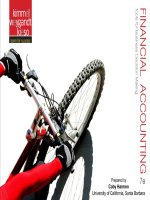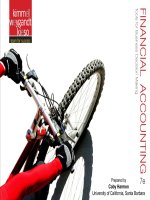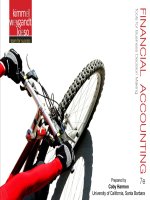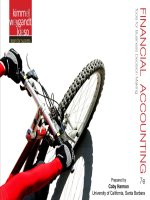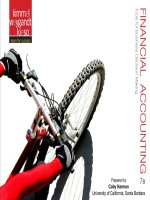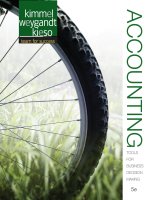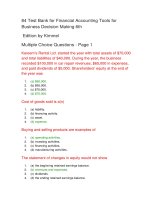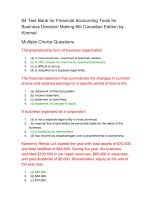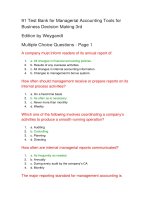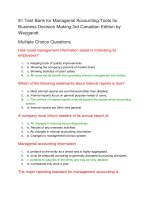accounting tools for business decision making 5e by kimmel kieso
Bạn đang xem bản rút gọn của tài liệu. Xem và tải ngay bản đầy đủ của tài liệu tại đây (41.82 MB, 1,424 trang )
This page is intentionally left blank
Paul D. Kimmel PhD, CPA
University of Wisconsin—Milwaukee
Milwaukee, Wisconsin
Jerry J. Weygandt PhD, CPA
University of Wisconsin—Madison
Madison, Wisconsin
Donald E. Kieso PhD, CPA
Northern Illinois University
DeKalb, Illinois
Dedicated to
the Wiley sales representatives
who sell our books and service
our adopters in a professional
and ethical manner, and to
Enid, Merlynn, and Donna
Vice President & Executive Publisher
Associate Publisher
Editorial Operations Manager
Content Editor
Associate Editor
Senior Development Editor
Development Editor
Senior Content Manager
Senior Production Editor
Associate Director of Marketing
Marketing Manager
Senior Product Designer
Product Designer
Media Specialist
Design Director
Cover Design
Interior Design
Production Management Services
Senior Photo Editor
Editorial Assistant
Marketing Assistant
Cover Photo
Title Page and Brief Contents Image
Sierra Corporation Icon
Continuing Cookie Chronicle Icon
Waterways Continuing Problem Icon
George Hoffman
Christopher DeJohn
Yana Mermel
Ed Brislin
Sarah Vernon
Terry Ann Tatro
Margaret Thompson
Dorothy Sinclair
Erin Bascom
Amy Scholz
Karolina Zarychta Honsa
Allison Morris
Greg Chaput
Daniela DiMaggio
Harry Nolan
Maureen Eide
Kristine Carney
Furino Production
Mary Ann Price
Jaclyn MacKenzie
Justine Kay
I Dream Stock Collection/Age Fotostock America, Inc.
I Dream Stock Collection/Age Fotostock America, Inc.
© Ben Blankenburg/iStockphoto
© Fekete Tibor/iStockphoto
© Perry Kroll/iStockphoto
This book was set in New Aster by Aptara®, Inc. and printed and bound by Courier-Kendallville.
The cover was printed by Courier-Kendallville.
Founded in 1807, John Wiley & Sons, Inc. has been a valued source of knowledge and understanding for more than 200 years,
helping people around the world meet their needs and fulfill their aspirations. Our company is built on a foundation of principles that
include responsibility to the communities we serve and where we live and work. In 2008, we launched a Corporate Citizenship Initiative,
a global effort to address the environmental, social, economic, and ethical challenges we face in our business. Among the issues we are
addressing are carbon impact, paper specifications and procurement, ethical conduct within our business and among our vendors, and
community and charitable support. For more information, please visit our website: www.wiley.com/go/citizenship.
Copyright © 2013, John Wiley & Sons, Inc. All rights reserved. No part of this publication may be reproduced, stored in a retrieval
system or transmitted in any form or by any means, electronic, mechanical, photocopying, recording, scanning or otherwise, except
as permitted under Sections 107 or 108 of the 1976 United States Copyright Act, without either the prior written permission of the
Publisher, or authorization through payment of the appropriate per-copy fee to the Copyright Clearance Center, Inc. 222 Rosewood
Drive, Danvers, MA 01923, website www.copyright.com. Requests to the Publisher for permission should be addressed to the
Permissions Department, John Wiley & Sons, Inc., 111 River Street, Hoboken, NJ 07030-5774, (201)748-6011,
fax (201)748-6008, website />Evaluation copies are provided to qualified academics and professionals for review purposes only, for use in their courses during the
next academic year. These copies are licensed and may not be sold or transferred to a third party. Upon completion of the review
period, please return the evaluation copy to Wiley. Return instructions and a free of charge return shipping label are available at
www.wiley.com/go/returnlabel. Outside of the United States, please contact your local representative.
ISBN-13 978-1-118-12816-9
Binder-Ready Version ISBN 978-1-118-34276-3
Printed in the United States of America
10 9 8 7 6 5 4 3 2 1
Brief Contents
1
2
3
4
5
6
7
8
9
10
11
12
13
14
15
16
17
18
19
20
21
22
23
24
Introduction to Financial Statements 2
A Further Look at Financial Statements 46
The Accounting Information System 100
Accrual Accounting Concepts 162
Merchandising Operations and the
Multiple-Step Income Statement 228
Reporting and Analyzing Inventory 282
Fraud, Internal Control, and Cash 334
Reporting and Analyzing Receivables 396
Reporting and Analyzing Long-Lived Assets 446
Reporting and Analyzing Liabilities 504
Reporting and Analyzing Stockholders’ Equity 568
Statement of Cash Flows 624
Financial Analysis: The Big Picture 688
Managerial Accounting 752
Job Order Costing 798
Process Costing 844
Activity-Based Costing 894
Cost-Volume-Profit 944
Cost-Volume-Profit Analysis: Additional Issues 984
Incremental Analysis 1040
Budgetary Planning 1080
Budgetary Control and Responsibility Accounting 1132
Standard Costs and Balanced Scorecard 1192
Planning for Capital Investments 1244
APPENDICES
A Specimen Financial Statements:
Tootsie Roll Industries, Inc. A-1
B Specimen Financial Statements:
The Hershey Company B-1
C Specimen Financial Statements: Zetar plc C-1
D Time Value of Money D-1
E Reporting and Analyzing Investments E-1
*F Payroll Accounting F-1
*G Subsidiary Ledgers and Special Journals G-1
*H Accounting for Partnerships H-1
*I Accounting for Sole Proprietorships I-1
*J Pricing J-1
Company Index
Subject Index
I-1
I-3
*Available at the book’s companion website, www.wiley.com/college/kimmel.
From the
Authors
Dear Student,
Why This Course? Remember your biology course in high school? Did you have
one of those “invisible man” models (or maybe something more high-tech than that)
that gave you the opportunity to look “inside” the human body? This accounting
course offers something similar. To understand a business, you have to understand
the financial insides of a business organization. An accounting course will help you
understand the essential financial components of businesses. Whether you are
looking at a large multinational company like Apple or Starbucks or a single-owner
software consulting business or coffee shop, knowing the fundamentals of accounting
will help you understand what is happening. As an employee, a manager, an investor,
a business owner, or a director of your own personal
finances—any of which roles you will have at some point
“Whether you are looking at a large
in your life—you will make better decisions for having
multinational company like Apple or
taken this course.
Why This Book? Hundreds of thousands of students
have used this textbook. Your instructor has chosen it
for you because of its trusted reputation. The authors
have worked hard to keep the book fresh, timely, and
accurate.
Starbucks or a single-owner software
consulting business or coffee shop,
knowing the fundamentals of accounting will help you understand what is
happening.”
This textbook contains features to help you learn best, whatever your learning style.
We invite you to browse through pages xxvi–xxx. These pages describe the main features
you will find in this textbook and explain their purpose.
How To Succeed? We’ve asked many students and many instructors whether there
is a secret for success in this course. The nearly unanimous answer turns out to be not
much of a secret: “Do the homework.” This is one course where doing is learning.
The more time you spend on the homework assignments—using the various tools
that this textbook provides—the more likely you are to learn the essential concepts,
techniques, and methods of accounting. Besides the textbook itself, the book’s
companion website also offers various support resources.
Good luck in this course. We hope you enjoy the experience and that you put to good
use throughout a lifetime of success the knowledge you obtain in this course. We are
sure you will not be disappointed.
Paul D. Kimmel
Jerry J. Weygandt
Donald E. Kieso
Your Team
for Success in Accounting
Wiley Accounting is your partner in accounting education.
We want to be the first publisher you think of when
it comes to quality content, reliable technology, innovative
resources, professional training, and unparalleled support
for your accounting classroom.
Your Wiley Accounting Team for Success is comprised
of three distinctive advantages that you won’t find
with any other publisher:
WileyPLUS
An Experienced Team
of Support Professionals
The WileyPLUS Account Managers understand the time
constraints of busy instructors who want to provide the best
resources available to their students with minimal headaches and
planning time. They know how intimidating new software can
be, so they are sure to make the transition easy and painless.
Author Commitment
Wiley Faculty Network
A Proven Author Team
of Inspired Teachers
A Team of Educators Dedicated
to Your Professional Development
The Team for Success authors bring years
of industry and academic experience to the
development of each textbook that relates
accounting concepts to real-world experiences. This cohesive
team brings continuity of writing style, pedagogy, and problem
material to each course from Principles to Intermediate so you
and your students can seamlessly progress from introductory
through advanced courses in accounting.
The Wiley Faculty Network (WFN) is a global
group of seasoned instructors who share
best practices in teaching with their peers.
Our Virtual Guest Lecture Series provides the
opportunity you need for professional development in an online environment that is relevant, convenient,
and collaborative. We are proud to be able to offer valuable CPE
credits to attendees of these seminars and workshops.
www.wileyteamforsuccess.com
Author Commitment
Collaboration. Innovation. Experience.
After decades of success as authors of textbooks like this one,
Paul Kimmel, Jerry Weygandt, and Don Kieso understand that
teaching accounting goes beyond simply presenting data. The
authors are truly effective because they know that teaching is
about telling compelling stories in ways that make each
concept come-to-life.
Teacher / Author / Professional
Through their textbooks, supplements, online learning tools,
and classrooms, these authors have developed a comprehensive
pedagogy that engages students in learning and faculty
with teaching.
These authors collaborate throughout the entire process. The
end result is a true collaboration where each author brings his
individual experience and talent to the development of every
paragraph, page, and chapter, thus creating a truly well-rounded,
thorough view on any given accounting topic.
Many Ways in One Direction
Our Team for Success has developed a teaching system that
addresses every learning style. Each year brings new insights,
feedback, ideas, and improvements on how to deliver the material
to every student with a passion for the subject in a format that
gives them the best chance to succeed.
The key to the team’s approach is in understanding that, just as
there are many different ways to learn, there are also many
different ways to teach.
In Their Own Words
Visit the Wiley Team for Success website to hear from the authors
first-hand as they discuss their teaching styles, collaboration, and
the future of accounting.
www.wileyteamforsuccess.com
Author
Commitment
Jerry Weygandt
Jerry J. Weygandt, PhD, CPA, is Arthur
Andersen Alumni Emeritus Professor of
Accounting at the University of Wisconsin—
Madison. He holds a Ph.D. in accounting
from the University of Illinois. Articles by
Professor Weygandt have appeared in the
Accounting Review, Journal of Accounting
Research, Accounting Horizons, Journal of
Accountancy, and other academic and
professional journals. These articles have
examined such financial reporting issues
as accounting for price-level adjustments,
pensions, convertible securities, stock option
contracts, and interim reports. Professor
Weygandt is author of other accounting and
financial reporting books and is a member
of the American Accounting Association,
the American Institute of Certified Public
Accountants, and the Wisconsin Society of
Certified Public Accountants. He has served
on numerous committees of the American
Accounting Association and as a member
of the editorial board of the Accounting
Review; he also has served as President
and Secretary-Treasurer of the American
Accounting Association. In addition, he has
been actively involved with the American
Institute of Certified Public Accountants
and has been a member of the Accounting
Standards Executive Committee (AcSEC) of
that organization. He has served on the FASB
task force that examined the reporting issues
related to accounting for income taxes
and served as a trustee of the Financial
Accounting Foundation. Professor Weygandt
has received the Chancellor’s Award for
Excellence in Teaching and the Beta Gamma
Sigma Dean’s Teaching Award. He is on
the board of directors of M & I Bank of
Southern Wisconsin. He is the recipient of
the Wisconsin Institute of CPA’s Outstanding
Educator’s Award and the Lifetime
Achievement Award. In 2001 he received
the American Accounting Association’s
Outstanding Educator Award.
Don Kieso
Paul Kimmel
Paul D. Kimmel, PhD, CPA, received his
bachelor’s degree from the University of
Minnesota and his doctorate in accounting
from the University of Wisconsin. He is an
Associate Professor at the University of
Wisconsin—Milwaukee, and has
public accounting experience with Deloitte
& Touche (Minneapolis). He was the recipient of the UWM School of Business Advisory
Council Teaching Award, the Reggie
Taite Excellence in Teaching Award and
a three-time winner of the Outstanding
Teaching Assistant Award at the University
of Wisconsin. He is also a recipient of
the Elijah Watts Sells Award for Honorary
Distinction for his results on the CPA exam.
He is a member of the American Accounting
Association and the Institute of Management
Accountants and has published articles in
Accounting Review, Accounting Horizons,
Advances in Management Accounting,
Managerial Finance, Issues in Accounting
Education, Journal of Accounting Education,
as well as other journals. His research
interests include accounting for financial
instruments and innovation in accounting
education. He has published papers and
given numerous talks on incorporating
critical thinking into accounting education,
and helped prepare a catalog of critical
thinking resources for the Federated Schools
of Accountancy.
Donald E. Kieso, PhD, CPA, received his
bachelor’s degree from Aurora University
and his doctorate in accounting from the
University of Illinois. He has served as
chairman of the Department of Accountancy
and is currently the KPMG Emeritus Professor
of Accountancy at Northern Illinois University.
He has public accounting experience with
Price Waterhouse & Co. (San Francisco
and Chicago) and Arthur Andersen & Co.
(Chicago) and research experience with the
Research Division of the American Institute of
Certified Public Accountants (New York). He
has done post doctorate work as a Visiting
Scholar at the University of California at
Berkeley and is a recipient of NIU’s Teaching
Excellence Award and four Golden Apple
Teaching Awards. Professor Kieso is the
author of other accounting and business
books and is a member of the American
Accounting Association, the American
Institute of Certified Public Accountants,
and the Illinois CPA Society. He has served
as a member of the Board of Directors
of the Illinois CPA Society, then AACSB’s
Accounting Accreditation Committees, the
State of Illinois Comptroller’s Commission, as
Secretary-Treasurer of the Federation
of Schools of Accountancy, and as
Secretary-Treasurer of the American
Accounting Association. Professor Kieso is
currently serving on the Board of Trustees
and Executive Committee of Aurora
University, as a member of the Board
of Directors of Kishwaukee Community
Hospital, and as Treasurer and Director of
Valley West Community Hospital. From 1989
to 1993 he served as a charter member of
the national Accounting Education Change
Commission. He is the recipient of the
Outstanding Accounting Educator Award
from the Illinois CPA Society, the FSA’s
Joseph A. Silvoso Award of Merit, the NIU
Foundation’s Humanitarian Award for Service
to Higher Education, a Distinguished Service
Award from the Illinois CPA Society, and
in 2003 an honorary doctorate from
Aurora University.
WileyPLUS is a research-based, online environment
for effective teaching and learning.
The market-leading homework experience in WileyPLUS offers:
A Blank Sheet of Paper Effect
The WileyPLUS homework experience, which includes type-ahead for account title entry, imitates a blank
sheet of paper format so that students use recall memory when doing homework and will do better in
class, on exams, and in their professions.
A Professional Worksheet Style
The professional, worksheet-style problem layouts help students master accounting skills while doing
homework that directly applies to the classroom and the real world.
The Opportunity
to Catch Mistakes
Earlier
Multi-part problems further help
students focus by providing
feedback at the part-level.
Students can catch their
mistakes earlier and access
content-specific resources at
the point of learning.
Type-ahead feature for
account title entry replaces
drop-down menus.
WileyPLUS includes a
full ebook, interactive
tutorials, assessment
capabilities, and
Blackboard integration.
www.wileyplus.com
Accelerate Learning and Improve Test Scores!
Quantum helps students master the core accounting topics and
skills needed to be successful in their accounting course.
Personal Step-by-Step Feedback and Immediate Answers to Student Questions
Quantum uses powerful artificial intelligence technology to interpret and explain why individual
student answers are right or wrong with personal step-by-step feedback.
Rather than wait until the next day to ask their instructor, students can now ask questions any time
and get the real-time help needed to understand and master the material.
ASK QUESTIONS
CHECK MY WORK
SHOW SOLUTION
Target Areas Where Students Need Most Help
Students also receive real-time “How Am I Doing?” progress reports showing concept mastery
and specific skills requiring more practice.
Quantum provides the individualized feedback that is proven to
increase test scores at least a full letter grade with less study time.
PACKAGED WITH A TEXTBOOK AND WileyPLUS, QUANTUM HELPS STUDENTS
MASTER ACCOUNTING WITH LESS STUDY TIME!
www.quantumsimulations.com
The Wiley Faculty
Network
The Place Where
Faculty Connect ...
The Wiley Faculty Network is a global community
of faculty connected by a passion for teaching
and a drive to learn and share. Connect with
the Wiley Faculty Network to collaborate with
your colleagues, find a mentor, attend virtual
and live events, and view a wealth of resources
all designed to help you grow as an educator.
Embrace the art of teaching—great things
happen where faculty connect!
Virtual Guest Lectures
Discover innovative ideas and
gain knowledge you can use.
• Training
• Virtual Guest Lectures
• Live Events
Explore your resources and
development opportunities.
•
•
•
•
Teaching Resources
Archived Guest Lectures
Recorded Presentations
Professional Development Modules
Connect with recognized leaders across disciplines
and collaborate with your peers on timely topics
and discipline-specific issues, many of which offer
CPE credit.
Live and Virtual Events
These invitation-only, discipline-specific events are
organized through a close partnership between the
WFN, Wiley, and the academic community near the
event location.
Technology Training
Discover a wealth of topic- and technology-specific
training presented by subject matter experts,
authors, and faculty where and when you need it.
Teaching Resources
Connect with colleagues—
your greatest resource.
• Find a Mentor
• Interest Groups
• Blog
Find out more at
www.WHEREFACULTYCONNECT.com
Propel your teaching and student learning to the
next level with quality peer-reviewed case studies,
testimonials, classroom tools, and checklists.
Connect with Colleagues
Achieve goals and tackle challenges more easily by
enlisting the help of your peers. Connecting with
colleagues through the WFN can help you improve
your teaching experience.
What’s New?
The Fifth Edition expands our emphasis on student learning and improves upon a teaching and
learning package that instructors and students have rated the highest in customer satisfaction in the
following ways:
Increased Managerial Accounting Coverage
This edition reflects our continuing commitment to provide thorough coverage of all managerial
accounting topics. We now offer separate chapters on incremental analysis (Chapter 20) and capital
budgeting (Chapter 24), as well as a new Appendix J on pricing.
Continued Emphasis on Helping Students Learn Accounting Concepts
Especially with this edition of the textbook, we have carefully scrutinized all chapter material to help
students learn accounting concepts. We revised existing explanations and illustrations as well as
added more explanations, examples, and illustrations. For example, we have added T-accounts in
the margin to illustrate the effect of accounting procedures as well as discussed how tight credit
policies nearly prevented Apple from fulfilling its first sale.
Corporate Social Responsibility
Today’s companies are evaluating not just their profitability but also their corporate social responsibility. In this edition, we have profiled some of these companies in the new People, Planet, and
Profit Insight boxes, such as PepsiCo, to highlight their sustainable business practices. We have also
added a new Broadening Your Perspective problem, Considering People, Planet, and Profit, which
offers students the opportunity to analyze current business practices.
Student-Friendly Companies
One of the goals of the financial accounting course is to orient students to the application of accounting
principles and techniques in practice. Accordingly, we have expanded our practice of using numerous
examples from real companies throughout the textbook to add more high-interest enterprises that we
hope will increase student engagement, such as Clif Bar, Groupon, REI, and Skechers. Also, beginning
in Chapter 14, we introduce Current Designs, a kayak-making company, and then follow-up with a new
decision-making problem in every chapter based on this real-world company.
Managerial Accounting Video Series
Through the use of real-world, cutting-edge companies, these videos (available in WileyPLUS)
engage students with a dynamic overview of managerial accounting topics. Students are then
motivated to further review the detailed tools, examples, and discussions presented in their
textbook, WileyPLUS course, and classroom lectures.
Enhanced Homework Material
In each chapter, we have updated Self-Test Questions, Questions, Brief Exercises, Do it! Review,
Exercises, Problems, and Research Cases. Financial analysis and reporting problems have
been updated in accordance with the new Tootsie Roll and Hershey financial statements. New
Considering People, Planet, and Profit problems are included to offer students experience in evaluating corporate social responsibility, and new Considering Your Costs and Benefits problems require
students to weigh the pros and cons of two alternatives.
Accuracy and Relevance
This edition was also subject to an overall, comprehensive revision to ensure that it is technically
accurate, relevant, and up-to-date. A chapter-by-chapter summary of content changes is provided in
the chart on the next two pages.
xi
Content Changes by Chapter
Chapter 1: Introduction to Financial Statements
• New Feature Story, on Clif Bar and its ESOP and
open-book management program.
• New discussion of LLCs and S corporations, to
reflect more current business practices.
• New People, Planet, and Profit Insight, on
evaluating companies on social practices as well
as on financial results.
• New Research Case on possible expanding role
of auditors.
Chapter 2: A Further Look at Financial Statements
• Updated to reflect new conceptual framework
terminology.
Chapter 3: The Accounting Information System
• Heavily revised Feature Story, now on MF
Global’s failure to segregate company accounts
from customer accounts.
• New Ethics Insight, on Credit Suisse Group’s
failure to properly write down value of its
securities.
• New Research Case based on Green Bay Packers’
annual report publication.
Chapter 4: Accrual Accounting Concepts
• New Feature Story, on Groupon and complexity
of accounting for its revenues.
• New People, Planet, and Profit Insight, on costs
of disposing discarded, possibly toxic, materials.
Chapter 5: Merchandising Operations and the
Multiple-Step Income Statement
• New Feature Story, on REI and its unique
business model.
• New use of recent REI and Dick’s Sporting
Goods financial statement information.
• Revised Ethics Insight box on improving
company clarity of financial disclosures by citing
eBay’s recent sale of Skype.
• New People, Planet, and Profit Insight, about
whether PepsiCo should market green.
Chapter 6: Reporting and Analyzing Inventory
• Added new Accounting Across the Organization
box, on Sony’s inventory management practices.
• New Research Case, on U.S. companies use of
LIFO.
• New Considering People, Planet, and Profit
Insight, about Caterpillar’s annual Sustainability
Report.
Chapter 7: Fraud, Internal Control, and Cash
• New People, Planet and Profit Insight, about the
need for an effective system of internal controls
for sustainability reporting.
• New Interpreting Financial Statements problem,
based on recent Ernst & Young global survey on
fraud.
Chapter 8: Reporting and Analyzing Receivables
• New Feature Story, about Nike, its products, and
its receivables management.
• Featured companies in chapter are now Nike and
Skechers, to increase student engagement.
• New example of Apple’s first sale, to demonstrate
importance of extending credit.
Chapter 9: Reporting and Analyzing Long-Lived
Assets
• Revised Feature Story and in-chapter examples,
to focus on JetBlue as well as include more recent
information about the airline industry.
• New People, Planet, and Profit Insight, about
Billiton’s sustainability report.
• New Research Cases, about goodwill and Best
Buy’s profitability.
Chapter 10: Reporting and Analyzing Liabilities
• Expanded EOC material: 2 new Questions, 3
new Brief Exercises, 2 new Exercises, new RealWorld Focus problem, new Interpreting Financial
Statements problem, new Considering People,
Planet, and Profit problem, and new All About
You problem.
Chapter 11: Reporting and Analyzing Stockholders’
Equity
• New Feature Story, about why Mark Zuckerberg
delayed taking Facebook public.
• New People, Planet, and Profit Insight, about
rising level of support for shareholder proposals
requesting action related to social and environmental issues.
• New Accounting Across the Organization box,
about how the recent financial crisis affected
companies’ dividend payouts.
• New Research Case, new Considering People,
Planet, and Profit problem, and new IFRS
Concepts and Application problem.
Chapter 12: Statement of Cash Flows
• Revamped Feature Story, to include more recent
information about Apple’s cash flow status.
• New Accounting Across the Organization box,
about Kodak’s need to sell plant assets to raise
cash.
• New Investor Insight, about how 42% of companies going public had audit opinions warning
about the companies’ risk of failure.
Chapter 13: Financial Analysis: The Big Picture
• Revised Feature Story, to include more recent
information about Warren Buffett as well as to
improve readability.
• New Investor Insight, about how recently some
companies have altered their pension-plan
accounting to avoid prior-year events to distort
current-year results.
• New Do it! box on ratio analysis.
Chapter 14 Managerial Accounting
• New Feature Story, on history and operations of
Current Designs (kayak-making company).
• New Management Insight, about importance of
U.S. factory jobs.
• New Corporate Social Responsibility section.
• Deleted chapter appendix (Accounting Cycle for
a Manufacturing Company).
Chapter 15 Job Order Costing
• New Feature Story, on Lynn Tilton, founder and
CEO of Patriarch Partners, the largest, womanowned U.S. business.
• Added more explanations and details (such as
T-accounts), to increase student understanding.
Chapter 16 Process Costing
• Changed example of company in Process Cost
Flow section to roller blade/skateboard wheel
manufacturer, to increase student appeal.
• New People, Planet, and Profit Insight, about
costs/benefits of remanufactured goods.
Chapter 17 Activity-Based Costing
• New Feature Story, on why Precor switched from
traditional costing to activity-based costing.
• Changed example company, in Example of ABC
versus Traditional Costing section, to producing
abdominal trainers to tie in with Precor.
• Rewrote definition/explanation of value-added
and non–value-added activities, as well as of
activity levels, to ensure student understanding.
• New Management Insight, summarizing a recent
survey of ABC practices by companies worldwide.
• New Real-World Focus problem, on use of ABC
in the financial services industry.
Chapter 18 Cost-Volume-Profit
• New Feature Story, on how Jeff Bezos started
and expanded Amazon.com’s operations.
• New People, Planet, and Profit Insight, on hydroponic farming/vertical farming.
• Added material on use of scatter plots in HighLow Method section, as well as provided supplement on regression analysis on book’s companion
website.
• New Real-World Focus problem, on how Barnes
and Noble’s current structure left it ill-prepared
for an e-book environment.
Chapter 19 Cost-Volume-Profit Analysis:
Additional Issues
• New Feature Story, still about Intel, but now
explaining why the computer chip giant experiences huge swings in its earnings.
• Provided more step-by-step explanations and
illustrations, so students will improve their understanding of why and how to compute break-even
points, target net income, and margin of safety.
• New Service Company Insight, about why Warren
Buffett acquired Burlington Northern Railroad.
• New Real-World Focus problem, on Smart
Balance’s employment and cost structure.
Chapter 20 Incremental Analysis (previously part of
Chapter 23)
• New Service Company Insight, about the relevant
revenues and costs of Amazon.com’s Prime free
shipping program.
• Expanded sunk cost discussion and illustrations,
to improve student understanding.
• New material on how behavioral decision-making
can affect whether or not to replace equipment.
• Expanded discussion of elimination of an
unprofitable segment to include fixed cost analysis.
• New section on other considerations in decisionmaking, e.g., qualitative factors and relationship
of incremental analysis and ABC.
Chapter 21 Budgetary Planning (previously
Chapter 20)
• Added more detailed explanation to the
Budgeting and Human Behavior section about
participative budgeting.
• Added marginal T-accounts to Production
Budget and Direct Materials Budget sections,
to illustrate flow of costs.
• New Service Company Insight, on the implications of budgetary optimism as it pertains to
governments.
• New Management Insight, on the potential
costs and benefits of a company stockpiling
raw materials.
• Added a second Comprehensive Do It! problem
on budgeted income statement and balance
sheet.
• New Considering Your Costs and Benefits
problem about whether student loans should
be considered as a source of income.
Chapter 22 Budgetary Control and Responsibility
Accounting (previously Chapter 21)
• New Service Company Insight, about
NBCUniversal’s response to Fox wanting to
reduce its TV licensing fee.
• Added graph to the solution for the Do It! on
flexible budgets, to increase student
understanding.
• Moved Management by Exception to within
Performance Evaluation discussion, for
better flow of chapter topics.
Chapter 23 Standard Costs and Balanced Scorecard
(previously Chapter 22)
• New Feature Story (and accompanying video) on
Starbucks’ origins and vision.
• New material and illustrations added, to enhance
explanation of the components of variances as
well as how to compute them.
• New People, Planet, and Profit Insight, highlighting Starbucks’ 10th annual Global Responsibility
Report and the company’s commitment to corporate social responsibility.
• New Real-World Focus problem referencing the
Wall Street Journal article, “In Risky Move, GM to
Run Plants Around Clock.”
• New Considering Your Costs and Benefits problem, addressing the extent to which financial
measures should influence medical care.
Chapter 24 Planning for Capital Investments (previously part of Chapter 23)
• New Feature Story, on how timing can affect
capital investments by the cruise-line industry.
• New section on additional considerations for
capital budgeting, such as intangible benefits,
profitability index for mutually exclusive
projects, risk analysis, and post-audit of investment projects.
• New Management Insights, about whether
Verizon’s investment in its 4G wireless service
will pay off and whether there is too much plant
capacity for manufacturing big-screen TVs.
• New Considering Your Costs and Benefits
problem, about calculating the NPVs of solar
panels.
Appendix J Pricing
• New appendix that discusses pricing goods for
external sales, pricing services, transfer pricing
for internal sales, transfers between divisions in
different countries, and other cost approaches
to pricing.
Active Teaching and Learning
Supplementary Material
For Instructors
For Students
In addition to the support instructors receive from WileyPLUS
and the Wiley Faculty Network, we offer the following useful
supplements.
Textbook Companion Website. On this website,
www.wiley.com/college/kimmel, students will find support
materials that include Exercises: Set B, Challenge Exercises,
Problems: Set C, Continuing Cookie Chronicle and
Waterways Continuing Problems, Appendices F–J, and
Cases for Managerial Decision-Making.
Textbook Companion Website. On this website,
www.wiley.com/college/kimmel, instructors will find
the Solutions Manual, Test Bank, Instructor’s Manual,
Computerized Test Bank, and other resources.
Solutions Manual. The Solutions Manual contains
detailed solutions to all questions, brief exercises, exercises, and problems in the textbook, as well as suggested
answers to the questions and cases. The estimated time
to complete exercises, problems, and cases is provided.
Study Guide.
The Study Guide includes a chapter
review and provides opportunities for practice through problems and multiple-choice exercises.
Instructor’s Manual. Included in each chapter are
lecture outlines with teaching tips, chapter reviews, and
review quizzes.
Working Papers. The working papers are partially
completed accounting templates that will help students
correctly format their textbook accounting solutions.
Working paper templates are available for all end-ofchapter brief exercises, exercises, problems, and cases.
Excel working papers are available in WileyPLUS.
Test Bank and Computerized Test Bank. The test
Quantum Tutors. Adaptive learning and assessment
bank and computerized test bank allow instructors to tailor
examinations according to learning objectives and learning
outcomes, including AACSB, AICPA, and IMA professional
standards. Achievement tests, comprehensive examinations,
and a final exam are included.
software that will help students master the core
accounting topics and skills necessary to be successful
in this course.
Mobile Applications. Quizzing and reviewing content
is available for download on iTunes.
PowerPoint™.
The PowerPoint™ presentations contain a combination of key concepts, images, and problems
from the textbook. They are a useful, animated tool for
classroom lectures.
Managerial Accounting Video Series. Through
the examples of real-world, cutting-edge companies,
these videos (available in WileyPLUS) engage students
with a dynamic overview of managerial accounting topics.
Students are then motivated to further review the detailed
tools, examples, and discussions presented in their
textbook, WileyPLUS course, and classroom lectures.
xv
Acknowledgments
Accounting, Fifth Edition, has benefitted greatly from the input of focus group participants, manuscript reviewers, those who have sent comments by letter or e-mail, ancillary authors, and proofers.
We greatly appreciate the constructive suggestions and innovative ideas of reviewers and the creativity and accuracy of the ancillary authors and checkers.
Prior Edition
Thanks to the following reviewers, focus group participants,
and others who provided suggestions for the Fourth Edition:
Sylvia Allen
Juanita Ardavany
Eric Blazer
Evangelie Brodie
Thane Butt
Sandra Byrd
Lisa Capozzoli
Siu Chung
Leslie Cohen
Rita Kingery Cook
Cheryl Copeland
Cheryl Crespi
Sue Counte
Robin D’Agati
Brent W. Darwin
Michael Deschamps
Gadis Dillon
Rafik Elias
Alan Falcon
Annette Fisher
Lance Fisher
Roger Gee
Lisa Gray
Los Angeles Valley College
Los Angeles Valley College
Millersville University
North Carolina State University
Champlain College
Missouri State University
College of DuPage
Los Angeles Valley College
University of Arizona
University of Delaware
California State University—Fresno
Central Connecticut State University
St. Louis Community College—Meramec
Palm Beach Community College
Allan Hancock College
Mira Costa College
Oakland University
University of California, Los Angeles
Loyola Marymount University
Glendale Community College
Oklahoma State University
San Diego Mesa College
Seminole State College and
Valencia Community College
Michael Haselkorn
Bentley University
Hassan Hefzi
California State PolyTech University—Pomona
M.A. “Maggie” Houston
Wright State University
Ryan Huldah
Iona College
Ann Kelly
Providence College
Mehmet Kocakulah
University of Southern Indiana
Wikil Kwak
University of Nebraska—Omaha
Barbara Lamberton
University of Hartford
Lihon Liang
Syracuse University
D. Jordan Lowe
Arizona State University
James Lukawitz
University of Memphis
Sue Marcum
American University
Sal Marino
Westchester Community College
Florence McGovern
Bergen Community College
Noel McKeon
Florida Community College at Jacksonville
Paul Mihalek
Central Connecticut State University
Jeanne Miller
Cypress College
William J. Nealon
Schenectady County Community College
Joseph M. Nicassio
Westmoreland County Community College
Garth Novack
University of Washington
Rosemary Nurre
San Mateo Community College
Marge O’Reilly-Allen
Rider University
Terry Patton
Midwestern State University
Sandra Pelfrey
Oakland University
Ronald Pierno
Florida State University
John Purisky
Salem State University
Karl Putnam
University of Texas—El Paso
Ray Reisig
Pace University, Pleasantville
Rod Ridenour
Montana State University—Bozeman
Larry Rittenberg
University of Wisconsin
Cecile M. Roberti
Community College of Rhode Island
Lawrence Roman
Cuyahoga Community College
Luther L. Ross
Central Piedmont Community College
xvi
Robert Russ
Nancy Sill
Gerald Smith
Vic Stanton
Howard Switkay
Diane Tanner
Michael Tydlaska
Joan Van Hise
Richard Van Ness
Ron Vogel
Barbara Warschawski
Wendy Wilson
Northern Kentucky University
Modesto Junior College
University of Northern Iowa
University of California, Berkley
Community College of Philadelphia
University of North Florida
Mountain View College
Fairfield University
Schenectady County Community College
College of Eastern Utah
Schenectady County Community College
Southern Methodist University
Fifth Edition
Thanks to the following reviewers, focus group participants,
and others who provided suggestions for the Fifth Edition:
Dawn Addington
Bruce Bradford
Duane Brandon
Gary Braun
Jerold K. Braun
Robert Braun
Leroy Bugger
Sandra Byrd
Lisa Capozzoli
Renee Castrigano
Gayle Chaky
Toni Clegg
Cheryl Copeland
Cheryl Corke
Paquita Davis-Friday
Larry DeGaetano
Ron Dustin
Barbara Eide
Ann Escaro
Janet Farler
Annette Fisher
Hubert Glover
Gloria Grayless
Siriyama Kanthi Herath
Bambi Hora
Robert Kenny
Marinilka Kimbro
Don Kovacic
Joseph Larkin
Richard Larkin
David Laurel
Maria Leach
Jason Lee
Harold Little
Nancy Lynch
Lois Mahoney
Florence McGovern
Mary Michel
Earl Mitchell
Kathy Munter
Michael Newman
Judy Peterson
Central New Mexico Community College
Fairfield University
Auburn University
University of Texas—El Paso
Daytona State College
Southeastern Louisiana University
Edison State College
Missouri State University
College of DuPage
Cleveland State University
Dutchess Community College
Delta College
California State University—Fresno
Genesee Community College
Baruch College
Montclair State University
Fresno City College
University of Wisconsin—La Crosse
McHenry County College
Pima Community College
Glendale Community College
Drexel University
Sam Houston State University
Georgia Institute of Technology
University of Central Oklahoma
The College of New Jersey
Gonzaga University
California State University—San Marcos
Saint Joseph’s University
South Texas College
Auburn University
SUNY Plattsburgh
Western Kentucky University
West Virginia University
Eastern Michigan University
Bergen Community College
Manhattan College
Santa Ana College
Pima Community College
University of Houston
Monmouth College
Janice Pitera
Robert Rambo
Ruthie G. Reynolds
John Ribezzo
Luther Ross
Susan Sadowski
Richard Sarkisian
Mary Jane Sauceda
Karl Schindl
Debbie Seifert
Valerie Simmons
Jaye Simpson
Mike Skaff
Pam Smith
Nancy Snow
Naomi Soderstrom
Patrick Stegman
Paul Swanson
Karen Tabak
Diane Tanner
Margaret Tanner
Joan Van Hise
Sheila Viel
Christopher Wallace
Kathryn Yarbrough
Judith Zander
Broome Community College
Roger Williams University
Howard University
Community College of Rhode Island
Central Piedmont Community College
Shippensburg University/UMUC
Camden County College
University of Texas—Brownsville
University of Wisconsin—Manitowoc
Illinois State University
University of Southern Mississippi
Tarrant County College Northwest
College of the Sequoias
Northern Illinois University
University of Toledo
University of Colorado—Boulder
College of Lake County
Illinois Central College
Maryville University
University of North Florida
University of Arkansas
Fairfield University
University of Wisconsin—Milwaukee
California State University—Sacramento
University of North Carolina—Charlotte
Grossmont College
Advisory Board Members
Lisa Capozzoli
Marina Grau
Michael Gurevitz
Marcye Hampton
Merrily Hoffman
Jeffrey Jones
James Racic
Steve Teeter
Geoffrey Tickell
Bob Urell
Wanda Wong
Judith Zander
College of DuPage
Houston Community College
Montgomery College—Rockville
University of Central Florida
San Jacinto College Central
College of Southern Nevada
Lakeland Community College
Utah Valley University
Indiana University of Pennsylvania
Irvine Valley College
Chabot College
Grossmont College
We thank Benjamin Huegel and Teresa Speck of St. Mary’s
University for their extensive efforts in the preparation of
the homework materials related to Current Designs. We
also appreciate the considerable support provided to us by
the following people at Current Designs: Mike Cichanowski,
Jim Brown, Diane Buswell, and Jake Greseth. We also benefited from the assistance and suggestions provided to us
by Joan Van Hise in the preparation of materials related to
sustainability.
We appreciate the exemplary support and commitment
given to us by associate publisher Chris DeJohn, marketing
manager Karolina Zarychta Honsa, operations manager Yana
Mermel, content editor Ed Brislin, development editors Terry
Ann Tatro and Margaret Thompson, lead product designer
Allie Morris, product designer Greg Chaput, vice president
of content management Sesha Bolisetty, designers Maureen
Eide and Kristine Carney, illustration editor Anna Melhorn,
photo editor Mary Ann Price, project editor Jeanine Furino
of Furino Production, Denise Showers at Aptara, Cyndy
Ancillary Authors,
Contributors, Proofers, and
Accuracy Checkers
We sincerely thank the following individuals for their hard work in
preparing the content that accompanies this textbook:
LuAnn Bean
Jack Borke
Richard Campbell
Sandra Cohen
Terry Elliott
James M. Emig
Larry R. Falcetto
Cecelia M. Fewox
Coby Harmon
Harry Howe
Doug Kieso
Kirk Lynch
Laura McNally
Kevin McNelis
Jill Misuraca
Barb Muller
Yvonne Phang
John Plouffe
Laura Prosser
Eileen M. Shifflett
Ellen Sweatt
Diane Tanner
Joan Van Hise
Sheila Viel
Alice Sineath
Teresa Speck
Lynn Stallworth
Doris Warmflash
Dick Wasson
Andrea Weickgenannt
Bernie Weinrich
Melanie Yon
Florida Institute of Technology
University of Wisconsin—Platteville
University of Rio Grande
Columbia College—Chicago
Morehead State University
Villanova University
Emporia State University
College of Charleston
University of California—Santa Barbara
SUNY—Geneseo
Aurora University
Sandhills Community College
Black Hills State College
New Mexico State University
University of Tampa
Arizona State University
Borough of Manhattan Community College
California State University—Los Angeles
Black Hills State University
James Madison University
Georgia Perimeter College
University of North Florida
Fairfield University
University of Wisconsin—Milwaukee
Forsyth Technical Community College
Saint Mary’s University of Minnesota
Appalachian State University
SUNY, Westchester Community College
Southwestern College
Xavier University
Lindenwood University
Taylor, project manager Matt Gauthier at Integra, and Katie
Trotta at ANSR. All of these professionals provided innumerable services that helped the textbook take shape.
Finally, our thanks to Amy Scholz, Susan Elbe, George
Hoffman, Tim Stookesberry, Joe Heider, and Steve Smith
for their support and leadership in Wiley’s College Division.
We will appreciate suggestions and comments from
users—instructors and students alike. You can send your
thoughts and ideas about the textbook to us via email at
Paul D. Kimmel
Milwaukee, Wisconsin
Jerry J. Weygandt
Madison, Wisconsin
Donald E. Kieso
DeKalb, Illinois
xvii
Contents
Chapter 1
Chapter 3
Introduction to Financial
Statements 2
The Accounting Information
System 100
Knowing the Numbers 3
Forms of Business Organization 4
Users and Uses of Financial Information 6
Internal Users 6
External Users 6
Ethics in Financial Reporting 8
Business Activities 9
Financing Activities 9
Investing Activities 10
Operating Activities 10
Communicating with Users 11
Income Statement 12
Retained Earnings Statement 13
Balance Sheet 14
Statement of Cash Flows 15
Interrelationships of Statements 16
Other Elements of an Annual Report 19
A Look at IFRS 43
Accidents Happen 101
The Accounting Information System 102
Accounting Transactions 102
Analyzing Transactions 103
Summary of Transactions 109
The Account 111
Debits and Credits 111
Debit and Credit Procedures 112
Stockholders’ Equity Relationships 115
Summary of Debit/Credit Rules 116
Steps in the Recording Process 116
The Journal 117
The Ledger 119
Chart of Accounts 120
Posting 120
The Recording Process Illustrated 121
Summary Illustration of Journalizing and
Posting 127
The Trial Balance 129
Limitations of a Trial Balance 129
Keeping an Eye on Cash 130
A Look at IFRS 159
Chapter 2
A Further Look at Financial
Statements 46
Just Fooling Around? 47
The Classified Balance Sheet 48
Current Assets 49
Long-Term Investments 50
Property, Plant, and Equipment 51
Intangible Assets 51
Current Liabilities 52
Long-Term Liabilities 53
Stockholders’ Equity 53
Using the Financial Statements 54
Ratio Analysis 54
Using the Income Statement 54
Using the Statement of Stockholders’ Equity 56
Using a Classified Balance Sheet 57
Keeping an Eye on Cash 61
Financial Reporting Concepts 63
The Standard-Setting Environment 63
Qualities of Useful Information 64
Assumptions in Financial Reporting 65
Principles in Financial Reporting 66
Cost Constraint 66
A Look at IFRS 95
xviii
Chapter 4
Accrual Accounting Concepts
162
Keeping Track of Groupons 163
Timing Issues 164
The Revenue Recognition Principle 164
The Expense Recognition Principle 165
Accrual versus Cash Basis of Accounting 166
The Basics of Adjusting Entries 167
Types of Adjusting Entries 168
Adjusting Entries for Deferrals 169
Adjusting Entries for Accruals 175
Summary of Basic Relationships 181
The Adjusted Trial Balance and Financial
Statements 183
Preparing the Adjusted Trial Balance 183
Preparing Financial Statements 184
Quality of Earnings 185
Closing the Books 188
Preparing Closing Entries 188
Preparing a Post-Closing Trial Balance 189
Summary of the Accounting Cycle 191
Keeping an Eye on Cash 191
APPENDIX 4A: Adjusting Entries in an Automated
World–Using a Worksheet 195
A Look at IFRS 225
Chapter 5
Merchandising Operations and
the Multiple-Step Income
Statement 228
Buy Now, Vote Later 229
Merchandising Operations 230
Operating Cycles 231
Flow of Costs 231
Recording Purchases of Merchandise 233
Freight Costs 234
Purchase Returns and Allowances 235
Purchase Discounts 236
Summary of Purchasing Transactions 237
Recording Sales of Merchandise 238
Sales Returns and Allowances 239
Sales Discounts 240
Income Statement Presentation 241
Sales Revenues 243
Gross Profit 243
Operating Expenses 243
Nonoperating Activities 244
Determining Cost of Goods Sold Under
a Periodic System 246
Evaluating Profitability 247
Gross Profit Rate 247
Profit Margin 249
Keeping an Eye on Cash 251
APPENDIX 5A: Periodic Inventory System 253
Recording Merchandise Transactions 253
Recording Purchases of Merchandise 254
Freight Costs 254
Recording Sales of Merchandise 254
Comparison of Entries—Perpetual vs. Periodic 255
A Look at IFRS 279
Chapter 6
Reporting and Analyzing
Inventory 282
“Where Is That Spare Bulldozer Blade?” 283
Classifying and Determining Inventory 284
Classifying Inventory 284
Determining Inventory Quantities 286
Inventory Costing 288
Specific Identification 288
Cost Flow Assumptions 289
Financial Statement and Tax Effects
of Cost Flow Methods 294
Keeping an Eye on Cash 296
Using Inventory Cost Flow Methods
Consistently 297
Lower-of-Cost-or-Market 298
Analysis of Inventory 299
Inventory Turnover 299
Analysts’ Adjustments for LIFO Reserve 301
APPENDIX 6A: Inventory Cost Flow Methods
in Perpetual Inventory Systems 305
First-In, First-Out (FIFO) 306
Last-In, First-Out (LIFO) 306
Average-Cost 307
APPENDIX 6B: Inventory Errors 308
Income Statement Effects 308
Balance Sheet Effects 309
A Look at IFRS 331
Chapter 7
Fraud, Internal Control, and Cash
334
Minding the Money in Moose Jaw 335
Fraud and Internal Control 336
Fraud 336
The Sarbanes-Oxley Act 337
Internal Control 337
Principles of Internal Control Activities 338
Limitations of Internal Control 345
Cash Controls 347
Cash Receipts Controls 347
Cash Disbursements Controls 350
Control Features: Use of a Bank 352
Bank Statements 352
Reconciling the Bank Account 353
Reporting Cash 358
Cash Equivalents 359
Restricted Cash 359
Managing and Monitoring Cash 360
Basic Principles of Cash Management 361
Keeping an Eye on Cash 362
APPENDIX 7A: Operation of the Petty Cash Fund 367
Establishing the Petty Cash Fund 367
Making Payments from Petty Cash 367
Replenishing the Petty Cash Fund 368
A Look at IFRS 393
Chapter 8
Reporting and Analyzing
Receivables 396
What’s Cooking? 397
Types of Receivables 398
Accounts Receivable 399
Recognizing Accounts Receivable 399
Valuing Accounts Receivable 400
xix
Notes Receivable 407
Determining the Maturity Date 408
Computing Interest 408
Recognizing Notes Receivable 409
Valuing Notes Receivable 409
Disposing of Notes Receivable 410
Financial Statement Presentation
of Receivables 411
Managing Receivables 412
Extending Credit 412
Establishing a Payment Period 413
Monitoring Collections 413
Evaluating Liquidity of Receivables 415
Accelerating Cash Receipts 417
Keeping an Eye on Cash 420
A Look at IFRS 444
Chapter 9
Reporting and Analyzing Long-Lived
Assets 446
A Tale of Two Airlines 447
Plant Assets 448
Determining the Cost of Plant Assets 449
To Buy or Lease? 452
Accounting for Plant Assets 453
Depreciation 453
Factors in Computing Depreciation 454
Depreciation Methods 454
Revising Periodic Depreciation 459
Expenditures During Useful Life 460
Impairments 461
Plant Asset Disposals 461
Analyzing Plant Assets 464
Return on Assets 464
Asset Turnover 465
Profit Margin Revisited 466
Intangible Assets 467
Accounting for Intangible Assets 468
Types of Intangible Assets 469
Financial Statement Presentation
of Long-Lived Assets 472
Keeping an Eye on Cash 473
APPENDIX 9A: Calculation of Depreciation Using
Other Methods 476
Declining-Balance 476
Units-of-Activity 477
A Look at IFRS 500
Chapter 10
Reporting and Analyzing
Liabilities 504
And Then There Were Two 505
xx
Current Liabilities 506
What Is a Current Liability? 506
Notes Payable 507
Sales Taxes Payable 507
Unearned Revenues 508
Current Maturities of Long-Term Debt 509
Payroll and Payroll Taxes Payable 510
Bonds: Long-Term Liabilities 512
Types of Bonds 512
Issuing Procedures 513
Determining the Market Price of Bonds 513
Accounting for Bond Issues 515
Issuing Bonds at Face Value 516
Discount or Premium on Bonds 516
Issuing Bonds at a Discount 517
Issuing Bonds at a Premium 519
Accounting for Bond Redemptions 520
Redeeming Bonds at Maturity 520
Redeeming Bonds before Maturity 521
Financial Statement Presentation
and Analysis 521
Balance Sheet Presentation 521
Keeping an Eye on Cash 522
Analysis 523
Off-Balance-Sheet Financing 525
APPENDIX 10A: Straight-Line Amortization 530
Amortizing Bond Discount 530
Amortizing Bond Premium 531
APPENDIX 10B: Effective-Interest Amortization 532
Amortizing Bond Discount 533
Amortizing Bond Premium 535
APPENDIX 10C: Accounting for Long-Term
Notes Payable 536
A Look at IFRS 564
Chapter 11
Reporting and Analyzing
Stockholders’ Equity 568
Oh Well, I Guess I’ll Get Rich 569
The Corporate Form of Organization 570
Characteristics of a Corporation 571
Forming a Corporation 574
Stockholder Rights 574
Stock Issue Considerations 575
Authorized Stock 576
Issuance of Stock 576
Par and No-Par Value Stocks 577
Accounting for Issues of Common Stock 577
Accounting for Treasury Stock 579
Purchase of Treasury Stock 580
Preferred Stock 581
Dividend Preferences 582
Liquidation Preference 583
Dividends 584
Cash Dividends 584
Stock Dividends 586
Stock Splits 588
Retained Earnings 590
Retained Earnings Restrictions 590
Financial Statement Presentation of
Stockholders’ Equity 591
Balance Sheet Presentation 591
Keeping an Eye on Cash 592
Measuring Corporate Performance 593
Dividend Record 593
Earnings Performance 594
Debt versus Equity Decision 595
APPENDIX 11A: Entries for Stock Dividends 599
A Look at IFRS 621
Chapter 12
Statement of Cash Flows
624
Got Cash? 625
The Statement of Cash Flows: Usefulness
and Format 626
Usefulness of the Statement of Cash Flows 626
Classification of Cash Flows 627
Significant Noncash Activities 628
Format of the Statement of Cash Flows 629
The Corporate Life Cycle 630
Preparing the Statement of Cash Flows 632
Indirect and Direct Methods 632
Preparation of the Statement of Cash
Flows–Indirect Method 633
Step 1: Operating Activities 635
Summary of Conversion to Net Cash Provided by
Operating Activities–Indirect Methods 638
Step 2: Investing and Financing Activities 640
Step 3: Net Change in Cash 641
Using Cash Flows to Evaluate a Company 642
Free Cash Flow 642
Keeping an Eye on Cash 644
Assessing Liquidity and Solvency Using
Cash Flows 645
APPENDIX 12A: Statement of Cash Flows–Direct
Method 649
Step 1: Operating Activities 651
Step 2: Investing and Financing Activities 655
Step 3: Net Change in Cash 656
APPENDIX 12B: Statement of Cash Flows—T-Account
Approach 656
A Look at IFRS 685
Chapter 13
Financial Analysis: The Big Picture
It Pays to Be Patient 689
Sustainable Income 690
Irregular Items 691
688
Changes in Accounting Principle 694
Comprehensive Income 695
Concluding Remarks 696
Comparative Analysis 697
Horizontal Analysis 698
Vertical Analysis 700
Ratio Analysis 703
Liquidity Ratios 704
Solvency Ratios 704
Profitability Ratios 705
Quality of Earnings 706
Alternative Accounting Methods 706
Pro Forma Income 706
Improper Recognition 707
Price-Earnings Ratio 707
APPENDIX 13A: Comprehensive Illustration
of Ratio Analysis 712
Liquidity Ratios 714
Solvency Ratios 716
Profitability Ratios 719
A Look at IFRS 748
Chapter 14
Managerial Accounting
752
Just Add Water . . . and Paddle 753
Managerial Accounting Basics 754
Comparing Managerial and Financial
Accounting 755
Management Functions 755
Organizational Structure 757
Business Ethics 758
Managerial Cost Concepts 759
Manufacturing Costs 760
Product versus Period Costs 761
Manufacturing Costs in Financial Statements 762
Income Statement 762
Cost of Goods Manufactured 763
Cost of Goods Manufactured Schedule 764
Balance Sheet 766
Cost Concepts—A Review 767
Product Costing for Service Industries 768
Managerial Accounting Today 769
Focus on the Value Chain 770
Balanced Scorecard 771
Corporate Social Responsibility 771
Chapter 15
Job Order Costing
798
She Succeeds Where Others Have Failed 799
Cost Accounting Systems 800
Job Order Cost System 800
Process Cost System 801
Job Order Cost Flow 802
Accumulating Manufacturing Costs 803
xxi
Assigning Manufacturing Costs to Work
in Process 805
Manufacturing Overhead Costs 809
Assigning Costs to Finished Goods 813
Assigning Costs to Cost of Goods Sold 814
Summary of Job Order Cost Flows 815
Job Order Costing for Service Companies 816
Advantages and Disadvantages of
Job Order Costing 818
Reporting Job Cost Data 819
Under- or Overapplied Manufacturing
Overhead 820
Chapter 16
Process Costing
844
Ben & Jerry’s Tracks Its Mix-Ups 845
The Nature of Process Cost Systems 846
Uses of Process Cost Systems 846
Process Costing for Service Companies 847
Similarities and Differences Between Job Order
Cost and Process Cost Systems 847
Process Cost Flow 849
Assigning Manufacturing Costs—Journal
Entries 850
Equivalent Units 853
Weighted-Average Method 853
Refinements on the Weighted-Average
Method 854
Production Cost Report 856
Compute the Physical Unit Flow
(Step 1) 857
Compute the Equivalent Units of Production
(Step 2) 858
Compute Unit Production Costs (Step 3) 858
Prepare a Cost Reconciliation Schedule
(Step 4) 859
Preparing the Production Cost Report 860
Costing Systems—Final Comments 862
APPENDIX 16A: FIFO Method 866
Equivalent Units Under FIFO 866
Comprehensive Example 867
FIFO and Weighted-Average 871
Chapter 17
Activity-Based Costing
894
Precor Is on Your Side 895
Traditional Costing and Activity-Based
Costing 896
Traditional Costing Systems 896
The Need for a New Approach 897
Activity-Based Costing 897
Example of ABC versus Traditional Costing 900
Identify and Classify Activities and Allocate
Overhead to Cost Pools (Step 1) 900
Identify Cost Drivers (Step 2) 901
xxii
Compute Activity-Based Overhead Rates
(Step 3) 901
Assign Overhead Costs to Products
(Step 4) 901
Comparing Unit Costs 903
Activity-Based Costing: A Closer Look 905
Benefits of ABC 905
Limitations of ABC 906
When to Use ABC 907
Value-Added versus Non–Value-Added
Activities 907
Classification of Activity Levels 909
Activity-Based Costing in Service
Industries 911
Traditional Costing Example 912
Activity-Based Costing Example 912
APPENDIX 17A: Just-in-Time Processing 916
Objective of JIT Processing 917
Elements of JIT Processing 918
Benefits of JIT Processing 918
Chapter 18
Cost-Volume-Profit
944
Don’t Worry—Just Get Big 945
Cost Behavior Analysis 946
Variable Costs 946
Fixed Costs 947
Relevant Range 948
Mixed Costs 950
Importance of Identifying Variable and
Fixed Costs 953
Cost-Volume-Profit Analysis 954
Basic Components 954
CVP Income Statement 955
Break-Even Analysis 958
Target Net Income 962
Margin of Safety 963
Chapter 19
Cost-Volume-Profit Analysis:
Additional Issues 984
Rapid Replay 985
Cost-Volume-Profit (CVP) Review 986
Basic Concepts 986
Basic Computations 988
CVP and Changes in the Business
Environment 989
Sales Mix 992
Break-Even Sales in Units 992
Break-Even Sales in Dollars 994
Determining Sales Mix with Limited
Resources 997
Cost Structure and Operating Leverage 1000
Effect on Contribution Margin Ratio 1001
Effect on Break-Even Point 1001
Effect on Margin of Safety Ratio 1001
Operating Leverage 1001
APPENDIX 19A: Absorption Costing versus
Variable Costing 1005
Example Comparing Absorption Costing with
Variable Costing 1005
An Extended Example 1008
Decision-Making Concerns 1012
Potential Advantages of Variable
Costing 1014
Chapter 20
Incremental Analysis
1040
Make It or Buy It? 1041
Management’s Decision-Making Process 1042
Incremental Analysis Approach 1043
How Incremental Analysis Works 1043
Types of Incremental Analysis 1045
Accept an Order at a Special Price 1045
Make or Buy 1046
Sell or Process Further 1049
Repair, Retain, or Replace Equipment 1052
Eliminate an Unprofitable Segment
or Product 1054
Other Considerations in DecisionMaking 1056
Chapter 21
Budgetary Planning
1080
The Next Amazon.com? Not Quite 1081
Budgeting Basics 1082
Budgeting and Accounting 1082
The Benefits of Budgeting 1083
Essentials of Effective Budgeting 1083
Length of the Budget Period 1083
The Budgeting Process 1084
Budgeting and Human Behavior 1084
Budgeting and Long-Range Planning 1085
The Master Budget 1086
Preparing the Operating Budgets 1087
Sales Budget 1087
Production Budget 1088
Direct Materials Budget 1090
Direct Labor Budget 1093
Manufacturing Overhead Budget 1094
Selling and Administrative Expense
Budget 1095
Budgeted Income Statement 1095
Preparing the Financial Budgets 1097
Cash Budget 1097
Budgeted Balance Sheet 1101
Budgeting in Nonmanufacturing Companies 1102
Merchandisers 1102
Service Companies 1103
Not-for-Profit Organizations 1104
Chapter 22
Budgetary Control and Responsibility
Accounting 1132
Turning Trash Into Treasure 1133
Budgetary Control 1134
Static Budget Reports 1135
Examples 1135
Uses and Limitations 1136
Flexible Budgets 1137
Why Flexible Budgets? 1137
Developing the Flexible Budget 1139
Flexible Budget—A Case Study 1140
Flexible Budget Reports 1143
Responsibility Accounting 1145
Controllable versus Noncontrollable Revenues
and Costs 1147
Principles of Performance Evaluation 1147
Responsibility Reporting System 1149
Types of Responsibility Centers 1152
Responsibility Accounting for Cost Centers 1153
Responsibility Accounting for Profit
Centers 1153
Responsibility Accounting for Investment
Centers 1156
APPENDIX 22A: Residual Income—Another
Performance Measurement 1163
Residual Income Compared to ROI 1164
Residual Income Weakness 1164
Chapter 23
Standard Costs and Balanced
Scorecard 1192
80,000 Different Caffeinated Combinations 1193
The Need for Standards 1194
Distinguishing Between Standards and
Budgets 1194
Why Standard Costs? 1195
Setting Standard Costs 1196
Ideal versus Normal Standards 1196
A Case Study 1196
Analyzing and Reporting Variances from
Standards 1200
Direct Materials Variances 1201
Direct Labor Variances 1204
Manufacturing Overhead Variances 1207
Reporting Variances 1209
Statement Presentation of Variances 1210
Balanced Scorecard 1210
APPENDIX 23A: Standard Cost Accounting
System 1216
xxiii
